 From the Wichita Pachyderm Club: Congressman Mike Pompeo delivered an update on the issues of the day and answered questions. Over 100 Pachyderm Club members and guests attended. This audio presentation was recorded on October 21, 2016.
From the Wichita Pachyderm Club: Congressman Mike Pompeo delivered an update on the issues of the day and answered questions. Over 100 Pachyderm Club members and guests attended. This audio presentation was recorded on October 21, 2016.


 From the Wichita Pachyderm Club: Congressman Mike Pompeo delivered an update on the issues of the day and answered questions. Over 100 Pachyderm Club members and guests attended. This audio presentation was recorded on October 21, 2016.
From the Wichita Pachyderm Club: Congressman Mike Pompeo delivered an update on the issues of the day and answered questions. Over 100 Pachyderm Club members and guests attended. This audio presentation was recorded on October 21, 2016.


A downtown Wichita project receives a small benefit from the city, with no mention of the really big money.
Today the Wichita City Council approved a subsidy for a project in downtown Wichita.
The city will lend the developer of a project at 303 S. Broadway $620,000 to improve the building’s facade. The property must repay this amount through an assessment on its property tax. The benefit to the property is that the city is able to borrow money at a lower interest rate, and this reduces the cost of borrowing for the project.
The agenda packet for this item states: “The Office of Urban Development has reviewed the economic (“gap”) analysis of the project and determined a financial need for incentives based on the current market.” This stems from the city’s policy on facade improvement projects, which is that the project would not be feasible except for this loan.1
Upon inquiry to the city, I was told that the facade improvement program would increase the developer’s return on investment from 7.06 percent to 8.35 percent. This seemed a stretch; that a small savings on interest costs on a small portion of the project cost could have such a large effect on profitability.
I asked the city for supporting documents that hold the figures used to calculate these amounts, but the city believes the Kansas Open Records Act does not allow it to release the records. In the past, however, I have received this information on request.
So, we’ll have to trust the city on this matter. I’m not comfortable with that. This is another example of the city conducting business within a cloud of secrecy.
The cost savings on borrowing $620,000 is just a small portion of subsidy this project will receive. Through tax credits, this project likely will receive over two million dollars in a form equivalent to cash.
The property was listed on the Register of Historic Kansas Places in August. This entitles the project to a tax credit of 25 percent of qualified expenses.2 With a project cost of $5,000,000, according to city documents, this tax credit could be worth $1,250,000.
From the National Park Service, a credit of 20 percent may be awarded.3 With a project cost of $5,000,000, according to city documents, this tax credit could be worth $1,000,000. It is not known at this time whether this project has qualified for this tax credit.
Together, the tax credits are worth potentially $2,250,000. Not all citizens may be aware of the mechanism of tax credits. In the case of the state of Kansas, the Department of Revenue will — figuratively — print a certificate that says the holder of this certificate may use it to pay $1,250,000 of state tax liability. It costs the state nothing to create this certificate. When the Department of Revenue receives the certificate instead of cash, the state gains nothing of economic value. The net economic effect is that the holder of the tax credit has been enriched by $1,250,000, and the state misses out on the same amount of revenue.4 Unless the state reduces its spending by the amount of the tax credit, the taxpayers have to make up the lost revenue.
This is not all. The project may apply for Industrial Revenue Bonds. This is a mechanism whereby a project may avoid paying property taxes and sales taxes.5 This property is located within a TIF district, so it is ineligible for property tax abatements. But, a sales tax exemption could be possible, if the developer applies.
That application is likely, as this developer did just that on another downtown Wichita building, also located in a TIF district, but eligible for sales tax exemption on purchases related to the redevelopment.6
Of note: This developer actively campaigned for the proposed 2014 Wichita city sales tax, offering free office space to the effort.7 Should he apply for a sales tax exemption on this property, this is another example of low-income families in Wichita paying sales tax on groceries, but well-off developers escaping paying that same tax.
At the council meeting, a citizen remarked how this project is good for the tax base. But, being in a TIF district, the incremental property taxes from this property will go to the TIF district, not the city, until the TIF debt is retired.
Council Member Janet Miller (district 6, north central Wichita) noted that the city is not contributing to the project, that the developer pays all the costs of the facade improvement loan. But of a direct contribution to the project, she said “Although I wouldn’t probably complain if that was a request.” I’d suggest that Miller read up on the economics of tax credits, and of a possible sales tax exemption. She might be surprised to learn how much cash this project is receiving.
—
Notes

As Kansans debate school funding, as the Kansas Supreme Court considers ordering more school spending, and as school spending boosters insist that school spending has been slashed, a fact remains constant: Kansas schools don’t spend all the money they’ve been given. Fund balances grew in many years, and rose rapidly this year.
Fund balances are necessary for cash flow management. The issue is what levels of balances are necessary. Based on recent data from the Kansas State Department of Education, fund balances rose rapidly after 2008, remained largely level from 2011 through 2015, and rose for 2016.
For the school year ending in 2015, total cash balances were $1,745,557,046. (This total does not include non-school funds like museums and recreation center funds.) For 2016, the figure was $1,871,026,493. This is an increase of $125,469,450, or 7.2 percent.
Kansans might wonder why schools did not spend some of these funds to offset cuts they have contended were necessary.
I’ve gathered data about unspent Kansas school funds and presented it as an interactive visualization. You may explore the data yourself by using the visualization. Click here to open the visualization in a new window. Data is from Kansas State Department of Education. Visualization created using Tableau Public.

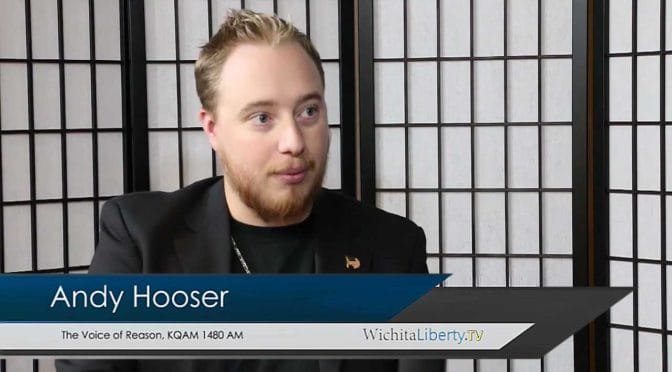
In this episode of WichitaLiberty.TV: Radio show host Andy Hooser visits the KGPT studios to talk about upcoming elections in Kansas and the presidential campaign. View below, or click here to view at YouTube. Episode 130, broadcast October 16, 2016.
Hooser’s radio show is The Voice of Reason with Andy Hooser. Its Facebook page is here, and the podcast is here.

The editorial boards of two large Kansas newspapers have shown how little effort goes into forming the opinions they foist upon our state.
Here’s a quote from a recent opinion piece in the Topeka Capital-Journal, the second-largest newspaper in Kansas: “If the past year is any indication, Totten is right about the harmful effects of KDOT sweeps on the construction industry in our state. According to the Bureau of Labor Statistics, between July 2015 and July 2016, Kansas lost 4,400 construction jobs — a 7.3 percent decline. This means Kansas ranked 49th in the country for construction job growth.” 1
Here, the newspaper argues that transferring money from the state’s highway fund has led to a loss of construction jobs in the state. Fortunately, there are some institutions and people in our state that will actually look at statistics to see what they mean. And if the editorial board of the Capital-Journal had done this, they would have realized they were fed a line of hooey by a self-interested lobbyist. You see, the “Totten” the newspaper cited as an authority is Bob Totten, Executive Vice President of Kansas Contractors Assocation.2 His job is to agitate for as much spending as possible to benefit his members. It matters not if the spending is wise or needed. The members of Kansas Contractors Association would happily build the proverbial bridge to nowhere, as long as they were paid.
The Capital-Journal was not alone in believing what Totten told them. The editorial board of the Wichita Eagle did, too. It wrote a similar editorial, telling Kansans “Over the past six years, Brownback and the Legislature have taken $2.7 billion in transportation funding to help pay other state bills, Totten said. The loss of this funding has meant fewer projects and fewer jobs.”3
The statistics that are cited deserve further investigation, which is what Kansas Policy Institute did in its article Media and highway contractors mislead again. KPI’s Dave Trabert reported this:
Had the Eagle bothered to examine Mr. Totten’s claim, they would have learned that only 2 percent of the construction job decline was attributable to highway construction and that the loss of 100 jobs is less than 1 percent of total highway jobs.
In addition to learning that Mr. Totten was grossly exaggerating, they would have learned that employment for construction of new homes and non-residential buildings showed very nice growth and the real problem is in specialty trade contractors for non-highway projects.
I verified these statistics and reported them in my article Kansas construction employment. I built an interactive visualization that anyone can use to explore this data.
The upshot is that Kansas highway construction jobs declined slightly, but the bulk of the job loss in construction was in other types of construction. Not in highway construction, as the highway construction lobbyist told Kansas editorial writers.
This is a sad episode in Kansas newspaper journalism. The editorial boards of two newspapers — one the state’s largest — accepted as true the claims of a lobbyist, apparently without spending a moment in verification. Both newspapers have staffs of reporters, some of which I’m sure are capable of accessing the Bureau of Labor Statistics to gather a few statistics and perform an independent investigation.
But that didn’t happen. Instead, it appears that these two newspapers accepted the claims of the Kansas Contractors Association at face value because it fit the editorialists’ world view — that view being that Sam Brownback is bad, state spending on everything has been slashed, and the only thing to do is raise taxes.
That’s an opinion, which is what newspaper editorial boards produce. Now Kansans know just how uninformed are these opinions.
—
Notes
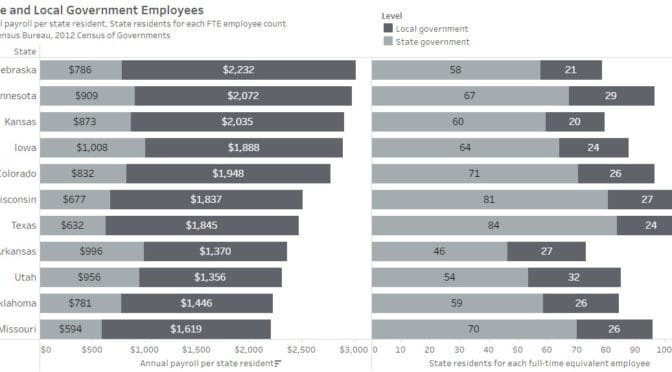
Is Kansas a frugal state, compared to others?
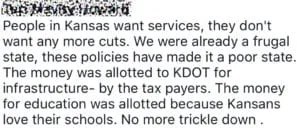 On Facebook, a person wrote “We were already a frugal state …” (I’ve obscured the name to protect the uninformed.)
On Facebook, a person wrote “We were already a frugal state …” (I’ve obscured the name to protect the uninformed.)
Is this true? What is the state and local government spending in Kansas, on a per-person basis? How does it compare to other states?
Every five years the U.S. Census Bureau conducts a census of governments. In its own words: “The Census of Governments identifies the scope and nature of the nation’s state and local government sector; provides authoritative benchmark figures of public finance and public employment; classifies local government organizations, powers, and activities; and measures federal, state, and local fiscal relationships.”1
I’ve gathered data from the 2012 census of governments — which is the most recent — and made it available in an interactive visualization. Nearby is a snapshot from the visualization, showing Kansas and nearby states, and a few others. (Using the visualization, you may select your own set of states to compare.)
In the visualization, you can see that Kansas spends quite a bit more than nearby states. Of special interest is Minnesota, which is often used as an example of a high-tax state, and a state with excellent schools and services. But Minnesota spends barely more than Kansas, on a per-person basis.
What about Colorado? It seems that Kansans often look to Colorado as a state full of bounty. But Kansas outspends Colorado. Same for New Mexico, Wisconsin, Texas, and — especially — Missouri.
So: Is Kansas a frugal state? It doesn’t seem it is.
Click here to access and use the visualization.

—
Notes
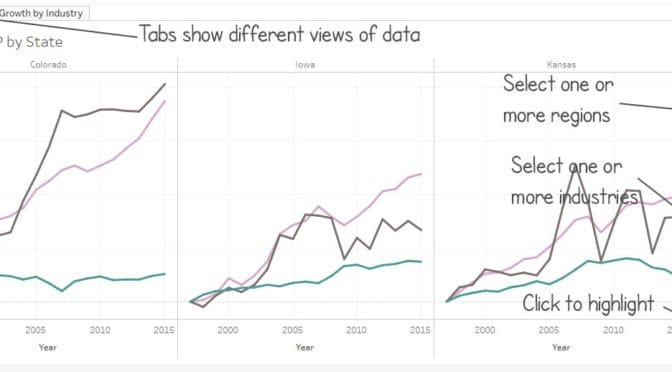
An interactive visualization of gross domestic product by state and industry.
The Bureau of Economic Analysis, a unit of the U.S. Department of Commerce, gathers data about economic output, known as gross domestic product. The visualization presented here presents this data in tabular and graphic form.
The GDP figures are real, meaning adjusted for inflation. They are annual numbers through 2015.

As indicated in the nearby table, some of the “industries” are actually subtotals of several industry components. The industry “All industry total” is the total GDP of all industries.
Source of data is Bureau of Economic Analysis, an agency of the United States Department of Commerce. Click here to access this visualization.

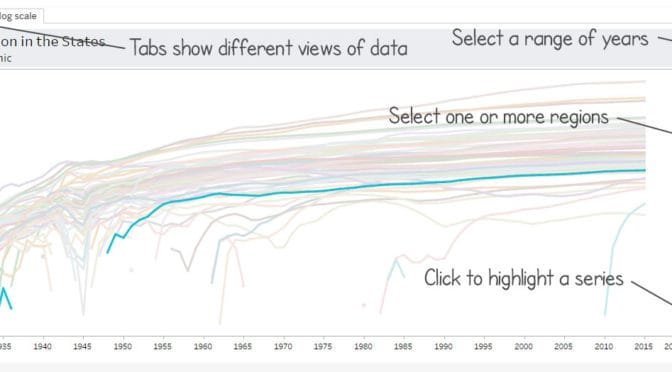
An interactive table and charts of populations in the states and regions, starting in 1929.
How have the states grown in population since 1929? Growth varies greatly.
In the accompanying visualization, one chart of the growth of population uses a logarithmic scale. This better shows a wide range of values. On this scale, negative values can’t be shown. The example shown in this article highlights Kansas against the other states.
Click here to access this visualization.
Source of data is Bureau of Economic Analysis, an agency of the United States Department of Commerce.


Kansas government spending, starting in 1967. Total spending and per capita spending, adjusted for inflation. Also spending as percent of Kansas GDP.
Sources of data:
* Kansas Fiscal Facts 2016
* 2016 and 2017 are approved figures, not actual spending
* 2015 and beyond population are my estimates
* CPI is Consumer Price Index – All Urban Consumers, CUUR0000AA0
* 2016 and later GDP is estimated
Click charts for larger versions.